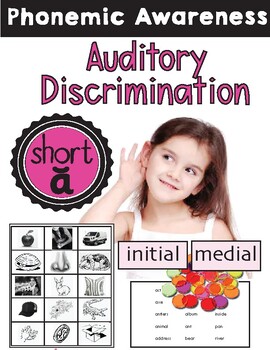

And therefore it does not come under the heading of auditory discrimination and sound errors!Ĭheck out the Facebook page: Aa is for Alpacas. However, by this stage, the issue is not one of auditory discrimination, but lack of listening to themselves. If children can’t detect when they are making speech errors in conversation, they are unlikely to generalise their new, correct sounds into conversation and would constantly need to be reminded by others. This is an issue with all speech therapy. DISCRIMINATING SOUNDS IN OTHER PEOPLE VERSUS SELF.īear in mind that it’s much easier to hear the differences between sounds when other people are saying them compared with listening to yourself. If they were still having difficulty in discriminating between the two sounds at this stage, leave it to the speech pathologist to direct you. Since the children requiring these sorts of activities can be quite young, they often won’t know whether or not the words are real anyway. Hopefully you won’t need a Step 3, which would be to identify whether real words contain /t/ or /k/. Go through this sequence with the consonant sounds at the beginning, then the end (/art, art/ etc.), then the middle (artar, artar/ etc.) Step 3. Similar activities are described in vowel discrimination. Change the order around, so you don’t end up with a pattern of same, different, different, same, as above. When successful, choose a different vowel and repeat the exercise. Choose ‘ar’ (a nice, open neutral sound for starters), and the possible combinations are /tar,tar/ /tar,kar/ /kar,tar/ /kar,kar/. Choose a vowel sound, and pair that with the combinations above. In this case we are looking at just consonant and vowel combinations, since the target sound is a consonant. You can find out all about nonsense words: what they are and how they are used for early reading, learning to rhyme and speech therapy. Step 2Ĭheck whether the child can hear the difference between the 2 sounds in nonsense words. Sometimes the child can hear the differences between the single sounds, but not when they are surrounded by other sounds.


If the child is correctly identifying whether all the variations are the same or different – good. (If the child is young, you may also need to be sure that they know what “same” and “different” are.) The possible pairs are /t,t/ /t,k/ /k,t/ /k,k/. If the target is /k/ and the child is saying /t/ as the error sound, say 2 sounds and ask whether they are the same or different. Step 1Ĭheck whether the child can hear the difference between the 2 single sounds. The first step is to check that the child is hearing/discriminating the difference between the error sound and the target. But frequently that won’t be enough, and the child will need to see a speech pathologist to remediate the errors. Sometimes that is enough for parents to be able to help the child learn the sound and apply it correctly.
#Auditory discrimination skills how to#
This was because the focus was on explaining the problems and giving tips on how to stimulate the sounds. In the articles on the speech sound problems /s,z/ and /k,g/, I didn’t refer to auditory discrimination. Auditory Discrimination and Sound Errors? Too young and wrong species! AUDITORY DISCRIMINATION COMES FIRST.


 0 kommentar(er)
0 kommentar(er)
